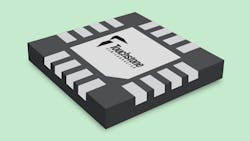3.5 µA Boost Regulator Offers Low-Power And Load Independence
Touchstone’s TS3300 boost plus linear regulator operates from supply voltages as low as 0.6 V up to 4.5 V and delivers at least 75 mA of continuous output current. Designed to be powered from a variety of sources including single or multiple-cell alkaline or single Li-chemistry batteries, the output voltage range can be user-set from 1.8 V to 5.25 V to power analog circuits, MCUs and Bluetooth radios simultaneously. While using 3.5 µA no-load supply current and configured to produce a 3 V output from a 1.2 V input source, efficiency performance is constant over a 100:1 span in output current. For powering low-energy radios, the device’s internal, low-dropout linear regulator delivers up to 100 mA output current while reducing boost-converter-generated output voltage ripple. Operating from low power sources, such as PV cells and three alkaline cells, the regulator is suitable for portable applications such as wireless sensors, RFID tags, wireless microphones, solar cell post-regulator/chargers, energy harvesting and personal health-monitoring devices. Fully specified over -40°C to +85°C, the TS3300 boost regulator is available now in a thermally-enhanced 16-pin 3x3 mm TQFN package priced at $0.85 each/1,000.
